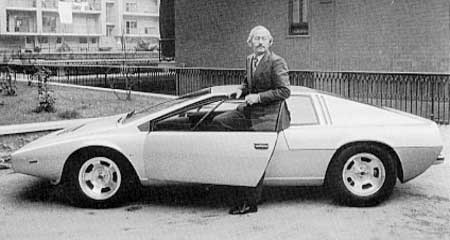


The Lotus Esprit was unveiled as the Silver Car concept at the Turin motor show in November 1972. Based on a Europa twin-cam chassis, it was developed to the point where the first Esprit prototype was displayed at the 1973 Geneva salon. It was another three years before the first customer cars were delivered in 1976. Designer Giorgetto Giugiaro had wanted to call the car Kiwi, but Lotus management was intent on a name beginning with the letter E, as is Lotus tradition. A tawl through the dictionary came up with Esprit, which it felt summed up the car's sprightliness.
The S1 was produced from 1975 to 1978 in which time only 894 made it off the production line. Many of these were for overseas which makes this car very rare indeed.


Made famous in the 1977 James Bond film 'the Spy Who Loved Me'. Roger Moore drove the Esprit in to the sea, where it then turned into a submarine. This one piece of Hollywood history turn the Esprit into a schoolboy's fantancy.
This is a colour picture of the original S1 tartan interior. Most S1 have been retrimmed with non-original materials and the tartan look of the few first few Esprits is very rare. For those looking to re-trim back to the original colours. This is how it should look. Finding the materials is another matter.
Esprit Production Figures
1976-2004

1976
LOTUS ESPRIT S1
Engine
Lotus 907 1973 cc four-cylinder in-line, 16-valve DOHC, two Dell’Orto
carburettors.
Power and Torque
160bhp @ 6200rpm
140lb ft @ 4900rpm
Body/Chassis
Glassfibre-reinforced plastic body with steel backbone chassis.
Passenger compartment encapsulated in a 'safety-cell structure'.
Transmission
Five-speed manual unit. Synchromesh on all forward gears; fifth gear is
overdrive,
Clutch: 8.5in diaphragm spring, hydraulically operated. Rear-wheel drive
Brakes
9.7in discs front
10.6in inboard discs rear
Dual braking system, split front/rear circuits
Steering
Rack-and-pinion
Castor: 3 to 3.5 degrees
Kingpin: 9 degrees.
Suspension
Front: Independent unequal length wishbones and coil springs.
Telescopic shock absorbers. Anti-roll bar.Camber 0 to 0.5 degrees, 3 to
5mm toe in
Rear: independent diagonal trailing arms and lateral link with fixed-length
driveshaft,
coil springs, telescopic shock absorbers.Camber 0 to 0.5 degrees, 8 to 10mm
toe in.
Wheels & Tyres
Front: 6J x 14
Rear: 7J x 14
Goodyear Grand Prix
Front: 195/70 HR14
Rear: 205/70 HR14
Weight
1980lb (898kg)
Performance
Top speed: 124mph
0-62mph: 6.8 sec
Fuel
Consumption: 26mpg.
Tank capacity: 15 gallons
Range: 450 miles
Cost new
£7883


The Silver Car

Colin Chapman was personally involved with the Esprit's development. Here, the photographer has caught him with the original 'Silver' Giugiaro design study in Turin. (Note the shiny Wolface wheels and outline are substantially correct, but that the screen angle had to be raised and fuel filler necks and caps moved from within the car to the three-quarter rear panels.

Giugiaro had never designed a glassfibre car before he tackled what became the Esprit, but got very close to the production shape in this first attempt. Deviations include twin wipers and chrome inlay bumper.

The Giugiaro original design for the Esprit had a detailed interior and was based on a stretched Europa chassis. Note the bonnet vents and lovingly chromed door handles, neither of which made it to the production Esprit.
Lotus Press Release
The Lotus Esprit, the body and interior of which was styled by Europe's leading stylist, Giorgetto Giugiaro, is manufactured utilising the very latest Glass Fibre Reinforced Plastic (G.F.R.P.) technology and incorporates many of the safety features proven in the successful Lotus Elite which, in 1975, was awarded Europe's most coveted safety award, the Don Safety Trophy.


The luxurious interior is upholstered in washable fabric giving maximum comfort, warmth in Winter and coolness in Summer, Fitted head restraints and deep comfortable semi-reclining seats give the driver and passenger superb comfort and minimum fatigue. Command and information services are grouped within a three panel console, the left hand panel provides lighting control, the central panel houses the environmental controls. The electric windows are housed the central tunnel accessible to both driver and passenger. Twin fuel tanks give the Esprit a total capacity of 15 gallons and a crusing range of approximately 450 miles. A total luggage capacity of 7 cu.ft. is provided in the front and rear compartments.
Four powerful headlamps are fully retractable for aerodynamic efficiency and can be instantly raised electrically at the touch of a button. The large laminated windscreen permits superb vision and is swept by a Lotus designed pantograph singe wiper system to give clear vision in the poorest weather conditions.
The primary safety design ensures that acceleration, handling and braking performance give a totally controllable vehicle under all conditions.
The secondary safety encompasses the structural design of body and chassis to afford the occupants a wide margin of protection in the event of a collision. The phenomenal impact qualities of glass fibre reinforced plastic (G.F.R.P.) plus the integral "safety cell" structure within the body shell of the Esprit set new standards of passenger security.
The Esprit, encompassing STYLE, PERFORMANCE and SAFETY with ECONOMY, truly represents TODAY'S CAR designed for TOMORROW.


|
|